We know the importance of staying safe while on the road and have researched all of the RV tire pressure monitoring systems (TPMS) to provide you with the best purchasing information in this guide!
Safely maintaining your tires is one of the most important tasks you have when you live full-time in your RV.
An RV tire pressure monitoring system, or TPMS for short, will keep track of every tire on rigs big and small. Low pressure isn’t a big deal… until it is. Nip the trouble in the bud to get to your destination faster, save on fuel economy, and add many more miles to the lifespan of your tires.
Nobody likes any blinking lights on their dashboard, but we’d always rather know about low tires at the gas station than halfway through a gravel road.
We’re not just driving to the grocery store. We’re hauling our house down the highway. Any tire blowout can be catastrophic.
And we shudder to think about what would happen if fifth wheels gave out at 70 mph. The weather, the terrain, and your payload will constantly affect your tire pressure.
We can’t think of one good reason to leave this valuable technology off the checklist. We use early warnings from tire pressure monitoring systems and a portable air compressor to quickly boost low pressure.
PRODUCT | WHAT WE LIKE | THINGS TO CONSIDER | |
Insert Custom HTML EEZ Tire TPMS EDITOR'S CHOICE |
|
| |
TST TPMS |
|
| |
Tymate RV TPMS |
|
| |
TireMinder Smart RV TPMS |
|
| |
Tire Safeguard 6-Tire TPMS |
|
| |
B-Qtech Solar Power TPMS |
|
| |
WonVon Wireless TPMS |
|
| |
TireMinder A1A TPMS |
|
|
There are loads of great reasons to trust this technology.
We’ll explore those reasons, as well as highlight the best TPMS cap sensors to give you the knowledge you need to keep your RV tires humming down the highway.
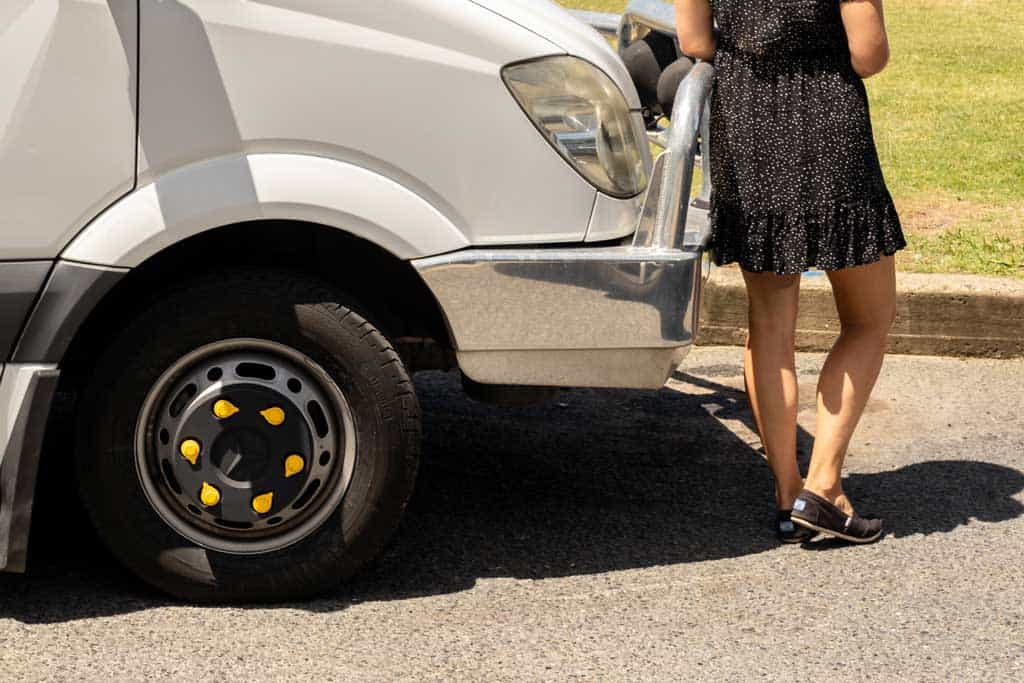
The Best TPMS for RV
Don’t head onto the highway without some reinforcements. Find your next RV tire pressure monitoring system in our list below.
The best RV TPMS sensors used multiple mounting options, temperature readings, audible alarms, and user-friendly monitoring systems to qualify for our list – perfect for keeping on top of your all-important tire safety.
EEZ Tire TPMS
The EEZ RV TPMS is an easy answer to your tire issues. It doesn’t get much easier to constantly monitor tire pressure than this, with 26 sensors available and a power-saving mode that reduces battery strain after 15 minutes in park.
Across the board, this system uses long-lasting sensor batteries for loads of information. The monitor lasts for up to 60 hours a charge.
The computer smartly handles trailer tire pressure with different expectations than RV’s tires to provide a complete sensor.
Under-inflated tires are expected just like death and taxes, but they don’t have to ruin a trip, especially if the EEZ tire pressure monitoring systems are on your RV gear list.
PROS
- Incredibly versatile system
- Power Saving shut off
- Sensors have replaceable batteries
CONS
- Trouble reaching larger 5th wheels
TST TPMS
Truck System Technologies has some experience monitoring tires hauling serious weight. Their RV tire pressure monitoring system picks up where the companies truck tech takes off.
Anything good enough for long-distance trucking operations is going to do wonders for your RV.
This system promises to last for a long, long time, and user-replaceable batteries will help the tire sensors stay attached for generations.
If batteries aren’t your style, you can hook up the monitor into your cigarette lighter with a USB port.
The direct TPMS ships with six sensors and can support up to 38, which is just a ridiculous amount of wheels to monitor if we’re being honest.
It’s not the cheapest tire pressure monitoring system out there, but this tire monitor system has proven to provide professional quality support to your tire pressure.
PROS
- Multiple mounting options and suction cup
- Great at simultaneous pressure monitoring
- Comes with a signal booster
CONS
- Low monitor battery life
- Expensive
Tymate RV TPMS
If you’re not towing an armada, you probably won’t need to keep track of too many tires. This simple 6-tire monitor system provides customizable data collection.
You can set your alarm values across five modes, covering everything from high pressure and rapid air leaks to low battery notifications.
All this data comes at an affordable price tag to help this tire monitor stand out in a crowd.
The monitor comes with a small panel that can recharge your sensor with solar power or a micro USB cable on cloudy days.
Tymate’s internal battery expects to last two years and can be replaced without buying a whole new RV TPMS. Loads of user-friendly features at a great price make this an excellent real-time tire pressure monitoring system.
PROS
- Solar charging
- Battery holds for 2 years
- Five types of health issue monitoring
CONS
- Does not have replaceable battery
TireMinder Smart RV TPMS
Some of the most brilliant people on the planet recognize the need to work with your friends for success.
This TireMinder communicates with a handy phone application to bring tire pressure monitoring into the 21st century.
Kind of like slapping QR codes onto your tire valve, four-tire sensors transmit data to your mobile phone that keeps you updated on your tire’s health.
The Tireminder smart TPMS comes with its own signal booster to provide the goods even in remote areas.
Expect the same great coverage as leading console TPMS. Your phone will be on top of your tire’s air pressure, high temperature, slow leaks, and tire blowout.
There is not always space for another piece of equipment on the dashboard. Keep all your information in your pocket with this intelligent monitoring system.
PROS
- Works with your smart phone
- Monitors up to 22 tires
- Great against a slow leak
CONS
- Does not come with its own display
- May need a signal booser on larger trailers
Tire Safeguard 6-Tire TPMS
Here we have another middle-ground option suitable for monitoring dual-wheel RVs and trailer tire pressure without a booster.
The assertive communication of this RV tire pressure monitoring system speaks with each tire individually and promises to be your one-stop shop for preventing tire failure.
This signal strength makes the tire safeguard an excellent choice for any six-wheeled second home.
An upgraded model can provide the same great data through eight sensors, giving the tire safeguard greater flexibility.
We’d rank this particular pressure monitoring system a bit higher on our list, but the company’s lackluster customer support puts us off a bit.
If you’re not the type to call support, this complete scanner serves any maverick RV trailer hauls well.
PROS
- Strong signal for larger RVs
- Several different size options
CONS
- Poor customer support
- Batteries are not user-replaceable
B-Qtech Solar Power TPMS
We’ve spent plenty of time cooking behind the dashboard to appreciate how strong solar power can be.
Put the sun to work with this RV tire pressure monitoring system that won’t need to plug into your cigarette lighter.
While solar energy hasn’t entirely caught up to 12V, this efficient monitor still packs an LCD screen covering your tire temperature and tire pressure drops.
If you’re staying underground awhile, you can still charge this RV TPMS through USB.
You won’t find the wide range of information that some other monitors provide, but everything you need to know is displayed on the home screen.
This tire pressure monitoring system makes our list by being the most energy-efficient model that doesn’t skimp on quality.
PROS
- Can charge with the sun or USB
- Totally wireless
- Loads of information
CONS
- Minimalist display
- Cannot be upgraded for more than 6 tires
WonVon Wireless TPMS
You may not need a $300 tire pressure monitoring system to keep tabs on your RV tires.
WonVon makes the most affordable direct TPMS on our list that keeps things brief.
The clear main screen provides a tire pressure and temperature monitor with four sensors.
We wish we could tell you this RV tpms is affordable without sacrificing quality, but it’s simply not the case.
These batteries will hardly get you through the summertime, as WonVon recommends changing out the batteries every 3-6 months.
Anyone looking for a quick and easy solution can lean on this technology to keep them in the loop until they have time to replace the tires at the end of the season.
Be warned: we just don’t expect this model to stand up to the test of time.
PROS
- Affordable
- Provides all the information you need
- 2 ways to charge
CONS
- Low battery life
- Won’t go above and beyond for your vehicle
TireMinder A1A TPMS
TireMinder has made a habit of providing the most user-friendly monitoring systems out there, and their A1A model is no exception.
Your pressure monitoring system will hook straight up to the dash with great mounting flexibility.
The high-tech display mimics modern smartphones, providing an intuitive interface that is easy to set up and will alert you to pressure problems quickly.
We don’t love the low battery life of the cap sensors. The replaceable batteries need refreshing once a month under constant use.
But the good news is, they are easy enough to replace yourself and won’t require replacing the entire system.
Temperature monitoring and slow leak data alert audibly and visually to make sure low pressure or high temperature won’t ruin a trip.
This technologically advanced system is one of the few tire monitors out there trying to be different.
PROS
- Handles like a smartphone
- User-replaceable batteries
- Lightweight across the board
CONS
- Low battery life
- Expensive
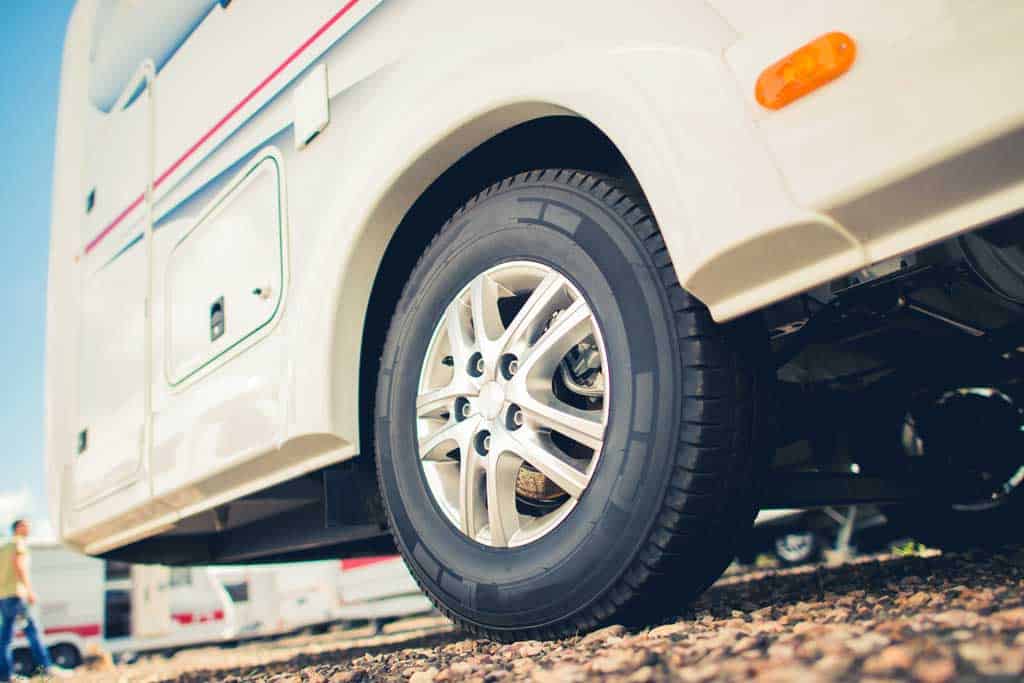
Choosing the Best Tire Pressure Monitoring System
Tires are notorious for picking the worst times to blow out, but the truth is, there is never a good time to get stuck on the side of the road.
You won’t find loads of variety in the market. Most RV tire pressure monitoring systems attach to your valve stems, and every reader on our list is just as capable against a slow leak as they are against rapid air loss.
However, there are subtle differences in the inner mechanics of these machines that will make each one feel a bit differently. Understand these key factors, and read through system reviews to better understand TPMS in action.
The best RV TPMS can’t prevent low pressure, but they will ensure low air pressure doesn’t turn into a flat tire.
Let’s check out different ways pressure monitoring systems get the job done.
READ MORE: Check out our guide to full-time van living for extra tips and hacks to make the most of your adventures!
Different Types:
Direct
Most TPMS sensors installed aftermarket are these gadgets that only require one-time installation. Attaching a sensor to each tire’s valve stem provides real-time information on air leakage and tire pressure.
This data communicates with a monitoring system display, typically mounted on your dashboard, that allows you to see the health of each tire.
A warning light indicates if an individual tire pressure has dropped 25% below its recommended level, and modern direct RV TPMS will also alert against high pressure and high temperature.
Every RV tire pressure monitoring system on our list is a direct TPMS.
Indirect
Indirect TPMS are hooked directly into an antilock braking system to sense how quickly each wheel is spinning. Indirect systems are more complicated, as they require frequent calibration and tricky installation.
Because of its complicated nature, this type of RV tire pressure monitoring system is hooked up in the early stages of an RV’s buildout and is not available for aftermarket install.
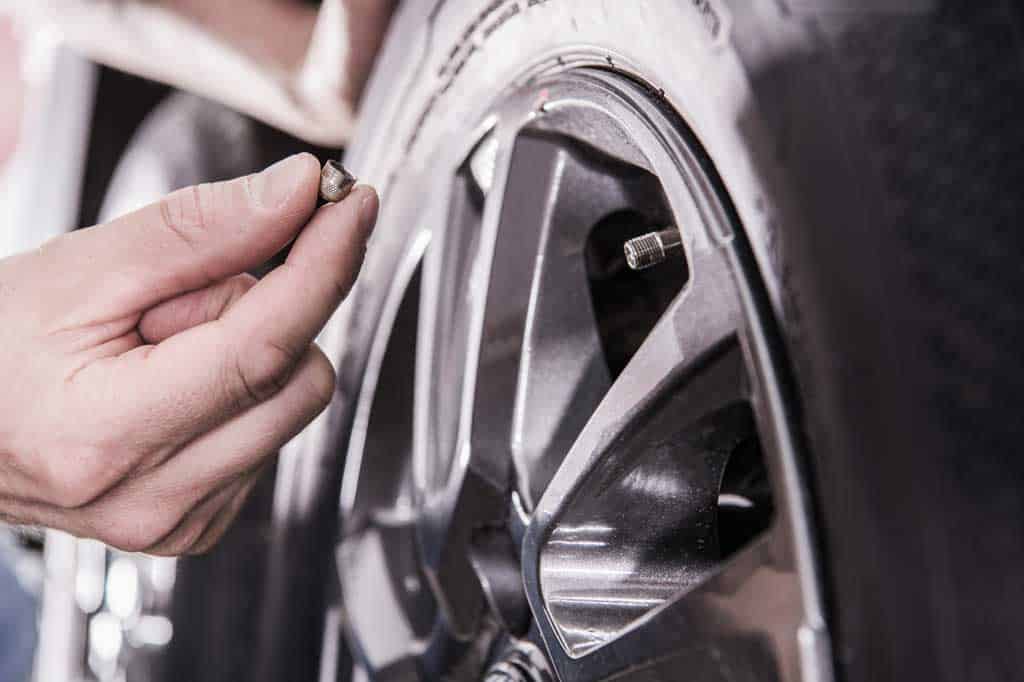
User Replacable Batteries
Every monitor has to get their power somewhere. You can recharge the LCD that receives data from your tire sensors through USB, cigarette lighter, or solar energy but don’t forget about the sensors.
If the cap sensors cannot have their battery replaced, you’ll have to buy new sensors or send in your system for replacement. These batteries can last anywhere from 6 months to many years, but you’ll eventually have to order a replacement.
We recommend purchasing a product with user-replaceable batteries if you plan to use your tire pressure monitoring system for more than a few trips a year. Even the longest-lasting products out there will wear out after a year or two of constant use.
Unfortunately, user-replaceable batteries aren’t always so easy to find. Your TPMS sensor will be right next to your wheel, which means it faces the same wear and tear as your vehicle’s tires.
Rain, mud, dirt, rocks, and asphalt will be flung at your sensor daily. To combat this, most RV TPMS use a potting material to completely seal in the technical materials that make the sensor work, like the battery.
This protective encasement means your TPMS will be weatherproof but also means you’ll likely have to replace the entire sensor any time it runs out of juice.
Display
All that data has to go somewhere. If you can’t understand the heads or tails of what your tire pressure monitor system’s display is translating, your system is worthless. A good monitor should clearly show the pressure and temperature monitoring reading for each tire.
We couldn’t believe our eyes when we saw a careless TPMS that flashed a red alert for low tire pressure but didn’t show the owner which tires were feeling low.
The point of a TPMS is to replace traditional techniques for checking tire pressure, not to function the same as a typical vehicle warning light.
Skip tire pressure monitoring systems that present loads of pressure reading numbers in an extensive list. The displays on our list rely on pictures, audio, and visual graphics to present as much information as possible while keeping things clear.
Tech-savvy RV owners should seriously consider a tire pressure monitoring system like the Tireminder that sends data straight to a cell phone app.
We find our dash gets constantly cluttered, especially on longer drives. The more flashing lights you have up there, the less impactful each display is.
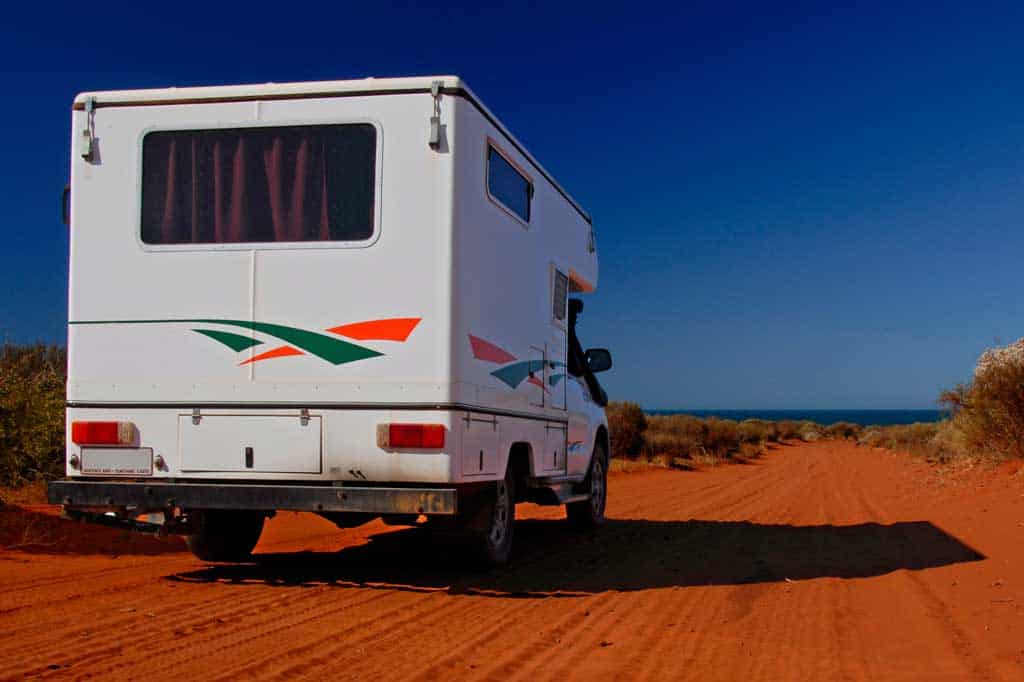
Installation
We haven’t recommended any RV tire pressure monitoring systems that will require a trip to the repair shop to install. Every TPMS on this list will be ready to go before the next long weekend, but we always recommend caution when it comes to installations.
Expect to spend a few hours calibrating the communication system between your display and your sensors. With a bit of tinkering, you should have each sensor hooked up to the display in a way that makes it easier to see the health of individual tires and make sure your tire pressure monitoring device is on the same page.
The sensors go directly onto valve stems, and your display will likely hook up to your air vents or 12V port. Take an extra few minutes to comb over reviews and any additional parts pages to make sure you have the full picture of an individual TPMS installation process.
EDITOR’S CHOICE:
EEZ Tire TPMS
EEZ Tire TPMS – Store data for up to 26 tires in both your RV and any trailer and tow vehicle combination.
Our favorite RV tire pressure monitor comes with a large intuitive display and a lengthy warranty.
Conclusion
You simply cannot eyeball a tire and know if it needs some help. RV tire pressure monitoring systems will alert you to issues in tire pressures that could eventually cause problems, giving you a priceless head start.
Modern systems come packed with bells and whistles that can make the technology seem complicated. Still, these are straightforward monitors that, once installed, will provide a constant stream of data on low and high pressure and tire temperature from the front to your trailer’s rear tires.
Combining long battery life with in-depth statistics and easy-to-understand display made our editor’s choice easy. The EEZ Tire TPMS provides everything you need to take your RV tire pressure into your own hands at an affordable price.
This post may contain affiliate links. That means if you make a purchase a product we recommend using the links in this article, we may receive a small commission at no extra cost to you. We promise to use this pocket money to buy lots of coffee and fuel for the campervan to keep us enjoying #VanLife for just a little longer. We appreciate your support, and only recommend products we know and trust. Thank you friends!








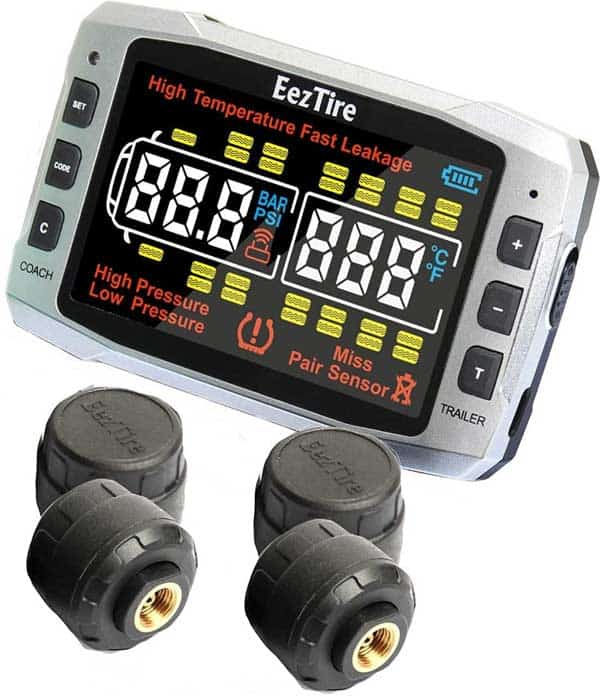

![The 4 BEST RV Wood Stoves – Ultimate Buyers Guide [2024]](https://vanlifetheory.com/wp-content/uploads/2021/10/RV-Wood-Stove-Feature-211x150.jpg)
![19 BEST Campervan Accessories [2023 Van Life Essentials]](https://vanlifetheory.com/wp-content/uploads/2020/08/Fairy-Lights-211x150.jpg)